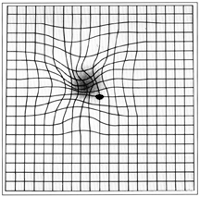Epiretinal membrane
(Redirected from Cellophane maculopathy)
Editor-In-Chief: Prab R Tumpati, MD
Obesity, Sleep & Internal medicine
Founder, WikiMD Wellnesspedia &
W8MD medical weight loss NYC and sleep center NYC
| Epiretinal membrane | |
|---|---|
| Synonyms | Macular pucker, cellophane maculopathy, surface wrinkling retinopathy |
| Pronounce | N/A |
| Specialty | N/A |
| Symptoms | Visual distortion, blurry vision, double vision |
| Complications | Retinal detachment, macular hole |
| Onset | Typically in adults over 50 |
| Duration | Chronic |
| Types | N/A |
| Causes | Idiopathic, retinal detachment, diabetic retinopathy, uveitis |
| Risks | Age, diabetes, eye surgery, eye trauma |
| Diagnosis | Ophthalmoscopy, optical coherence tomography |
| Differential diagnosis | Macular degeneration, retinal vein occlusion |
| Prevention | N/A |
| Treatment | Vitrectomy, observation |
| Medication | None specific, anti-VEGF for associated conditions |
| Prognosis | Variable, often stable, can improve with surgery |
| Frequency | Common in older adults |
| Deaths | N/A |
Epiretinal Membrane (ERM), also known as macular pucker or cellophane maculopathy, is a condition where a thin, transparent layer of fibrous tissues forms on the inner surface of the retina, particularly over the macula, which is responsible for sharp central vision. This condition can lead to vision distortion and blurring. ERMs are more common in individuals over the age of 50, but they can occur at any age.
Causes and Risk Factors[edit | edit source]
The exact cause of epiretinal membrane formation is not fully understood. However, it is often associated with changes in the vitreous humor – the gel-like substance filling the eye. As people age, the vitreous may shrink and separate from the retina, a process known as Posterior Vitreous Detachment (PVD). This can lead to the formation of ERMs. Other risk factors include:
- Retinal detachment
- Retinal tear
- Inflammation inside the eye (Uveitis)
- Eye surgeries
- Trauma to the eye
Symptoms[edit | edit source]
Symptoms of an epiretinal membrane can vary from none to severe, depending on the membrane's thickness and location. Common symptoms include:
- Blurred vision
- Distorted vision (straight lines appear wavy)
- Difficulty reading or performing tasks that require detailed vision
- Double vision in the affected eye
Diagnosis[edit | edit source]
Diagnosis of an epiretinal membrane is primarily based on a comprehensive eye examination. Key diagnostic tools include:
- Ophthalmoscopy: An examination of the retina's condition through a dilated pupil.
- Optical Coherence Tomography (OCT): A non-invasive imaging test that provides detailed images of the retina, allowing for the visualization of the membrane's presence and thickness.
Treatment[edit | edit source]
Treatment for an epiretinal membrane may not be necessary if symptoms are mild. Monitoring the condition with regular eye exams may be all that is needed. For more severe cases affecting vision, the surgical removal of the membrane may be recommended. The procedure, known as vitrectomy, involves removing the vitreous gel and peeling away the membrane from the retina. Surgery can improve vision, but it may not restore it to normal, and there are risks involved, including cataract formation and retinal detachment.
Prognosis[edit | edit source]
The prognosis for individuals with an epiretinal membrane varies. Some people may experience a gradual improvement in their symptoms, while others may notice a progressive worsening. Surgical intervention has a good success rate in improving vision, but as with any surgery, outcomes can vary.
Prevention[edit | edit source]
There are no specific measures to prevent the formation of an epiretinal membrane. However, maintaining overall eye health through regular eye exams can help in early detection and management of conditions that could potentially lead to ERM.
Search WikiMD
Ad.Tired of being Overweight? Try W8MD's physician weight loss program.
Semaglutide (Ozempic / Wegovy and Tirzepatide (Mounjaro / Zepbound) available.
Advertise on WikiMD
|
WikiMD's Wellness Encyclopedia |
| Let Food Be Thy Medicine Medicine Thy Food - Hippocrates |
Translate this page: - East Asian
中文,
日本,
한국어,
South Asian
हिन्दी,
தமிழ்,
తెలుగు,
Urdu,
ಕನ್ನಡ,
Southeast Asian
Indonesian,
Vietnamese,
Thai,
မြန်မာဘာသာ,
বাংলা
European
español,
Deutsch,
français,
Greek,
português do Brasil,
polski,
română,
русский,
Nederlands,
norsk,
svenska,
suomi,
Italian
Middle Eastern & African
عربى,
Turkish,
Persian,
Hebrew,
Afrikaans,
isiZulu,
Kiswahili,
Other
Bulgarian,
Hungarian,
Czech,
Swedish,
മലയാളം,
मराठी,
ਪੰਜਾਬੀ,
ગુજરાતી,
Portuguese,
Ukrainian
Medical Disclaimer: WikiMD is not a substitute for professional medical advice. The information on WikiMD is provided as an information resource only, may be incorrect, outdated or misleading, and is not to be used or relied on for any diagnostic or treatment purposes. Please consult your health care provider before making any healthcare decisions or for guidance about a specific medical condition. WikiMD expressly disclaims responsibility, and shall have no liability, for any damages, loss, injury, or liability whatsoever suffered as a result of your reliance on the information contained in this site. By visiting this site you agree to the foregoing terms and conditions, which may from time to time be changed or supplemented by WikiMD. If you do not agree to the foregoing terms and conditions, you should not enter or use this site. See full disclaimer.
Credits:Most images are courtesy of Wikimedia commons, and templates, categories Wikipedia, licensed under CC BY SA or similar.
Contributors: Prab R. Tumpati, MD



